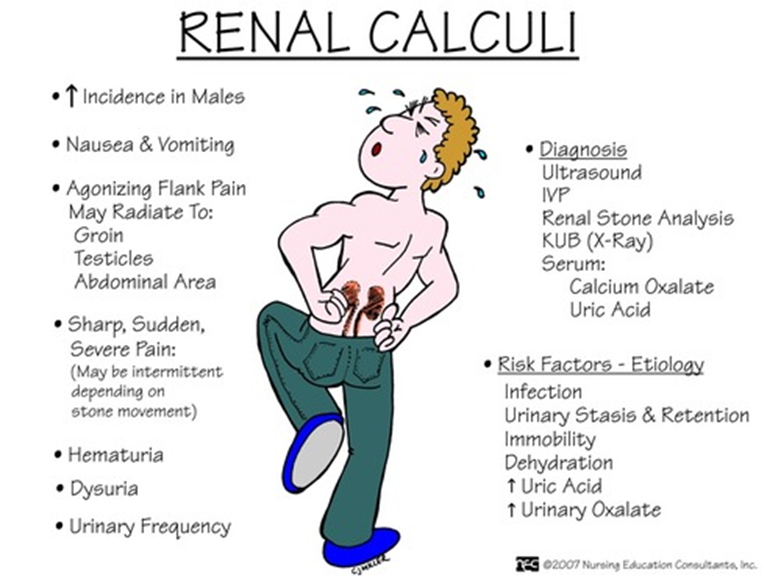The nurse is obtaining a health history from a new client who has a history of kidney stones. Which statement by the client indicates an increased risk for renal calculi?
Jogs more frequently than usual daily routine.
Eats a vegetarian diet with cheese 2 to 3 times a day.
Experiences additional stress since adopting a child.
Drinks several bottles of carbonated water daily
The Correct Answer is D
A. Jogs more frequently than usual daily routine:
Exercise, including jogging, is generally not associated with an increased risk of renal calculi. In fact, regular physical activity can have health benefits.
B. Eats a vegetarian diet with cheese 2 to 3 times a day:
A vegetarian diet alone is not necessarily a risk factor for renal calculi. However, the inclusion of high-oxalate foods, such as certain types of cheese, may contribute to the formation of kidney stones.
C. Experiences additional stress since adopting a child:
Stress is not a direct risk factor for renal calculi. However, certain dietary and lifestyle factors play a more significant role in stone formation.
D. Drinks several bottles of carbonated water daily:
This is the correct answer. Consuming large amounts of carbonated water, especially if it is high in phosphoric acid, can contribute to the formation of kidney stones. Carbonated beverages may increase the excretion of calcium in the urine, potentially leading to stone formation.

Nursing Test Bank
Naxlex Comprehensive Predictor Exams
Related Questions
Correct Answer is B
Explanation
A. Carcinogens are substances that contain cancerous cells:
This statement is incorrect. Carcinogens are substances that have the potential to cause cancer, but they do not necessarily contain cancerous cells themselves.
B. Substances that change a cell so that it becomes cancerous are potential sources of cancer:
This is the correct answer. Carcinogens are agents that can induce changes in the genetic material of cells, leading to the development of cancer. They can initiate or promote the process of carcinogenesis.
C. Environmental factors such as sunlight and chemicals can cause cancer to spread:
This statement is not accurate. Carcinogens can contribute to the initiation or promotion of cancer, but the spread of cancer (metastasis) involves complex biological processes and is not directly caused by environmental factors.
D. Carcinogens are in the environment and cannot be avoided:
This statement is not accurate. While carcinogens may be present in the environment, efforts can be made to minimize exposure and adopt preventive measures. Avoidance of known carcinogens and the promotion of a healthy lifestyle can contribute to cancer prevention.
Correct Answer is D
Explanation
A. Guidelines for oxygen use:
While guidelines for oxygen use are important, addressing the root cause of the respiratory condition, which includes smoking cessation, is crucial for long-term management.
B. Methods for weight loss:
Obesity can contribute to respiratory issues, but in the immediate context of emphysema exacerbation and the need for oxygen therapy, smoking cessation is a more urgent concern.
C. Approaches to conserve energy:
Conserving energy is important for clients with emphysema, but addressing the impact of smoking on respiratory function is a more immediate priority.
D. Strategies for smoking cessation.
Smoking is a major contributor to the progression of emphysema and exacerbation of respiratory symptoms. Addressing smoking cessation is crucial in improving the client's respiratory function and overall health. Continuing to smoke can exacerbate emphysema and compromise the effectiveness of other interventions, including oxygen therapy.
Whether you are a student looking to ace your exams or a practicing nurse seeking to enhance your expertise , our nursing education contents will empower you with the confidence and competence to make a difference in the lives of patients and become a respected leader in the healthcare field.
Visit Naxlex, invest in your future and unlock endless possibilities with our unparalleled nursing education contents today
Report Wrong Answer on the Current Question
Do you disagree with the answer? If yes, what is your expected answer? Explain.
Kindly be descriptive with the issue you are facing.
